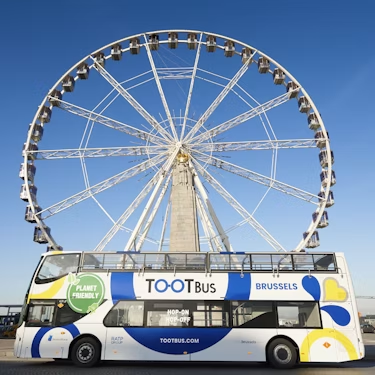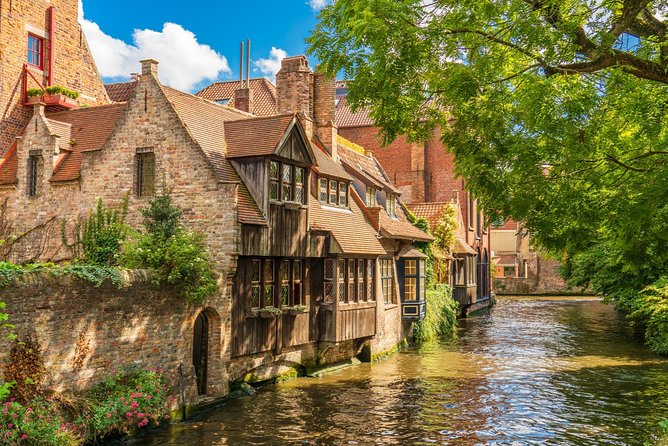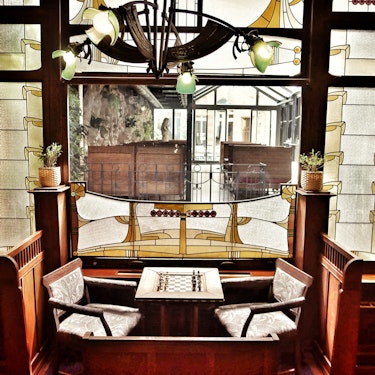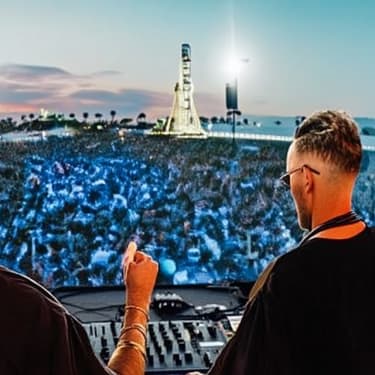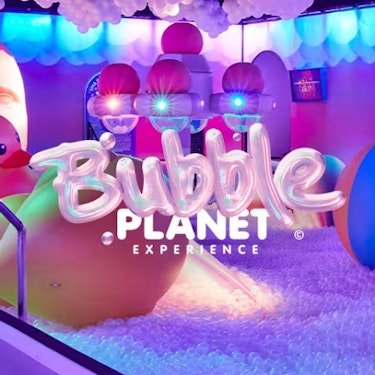More about: 22 Best Things to Do in Brussels
The size of Belgium's capital is ideal for a weekend break, but you'll definitely want to extend your trip to visit nearby cities such as the legendary Bruges. Here's everything you need to know to make the most of your visit to Brussels.
1. Explore the Grand Place
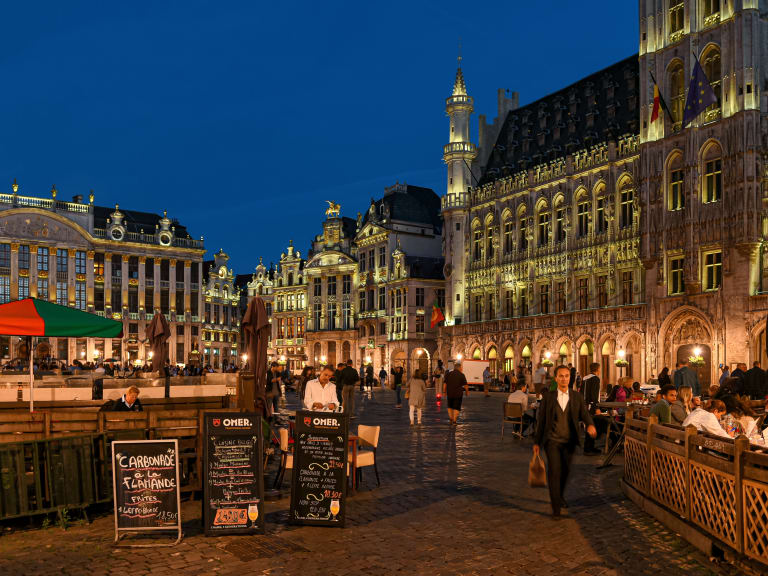
A stroll around the Grand Place in Brussels will allow you to discover the historical and aesthetic heart of the city. This magnificent square is one of Europe's most iconic destinations and an architectural gem that reflects the rich history and cultural influence of the Belgian capital. Surrounded by the Town Hall, a visit to the Grand Place is one of the best outdoor activities in Brussels and an ideal setting for taking photographs.
The buildings surrounding the Grand Place are a showcase of the Gothic and Baroque architecture that characterises the city. The ornate façades, decorative details and sculptures bear witness to the wealth and splendour that Brussels enjoyed during its historical heyday.
Practical information
How to get there: Explore at your own pace or on one of the guided tours and city excursions; many depart from there.
- How to visit: Explore at your own pace or on one of the guided tours and city excursions; many depart from there.
- Price: Tours start at RM168, some include chocolate tasting!
- Tip: Visit at night to see the buildings lit up; the atmosphere changes completely and is perfect for taking photos.
2. Discover the Manneken Pis statue
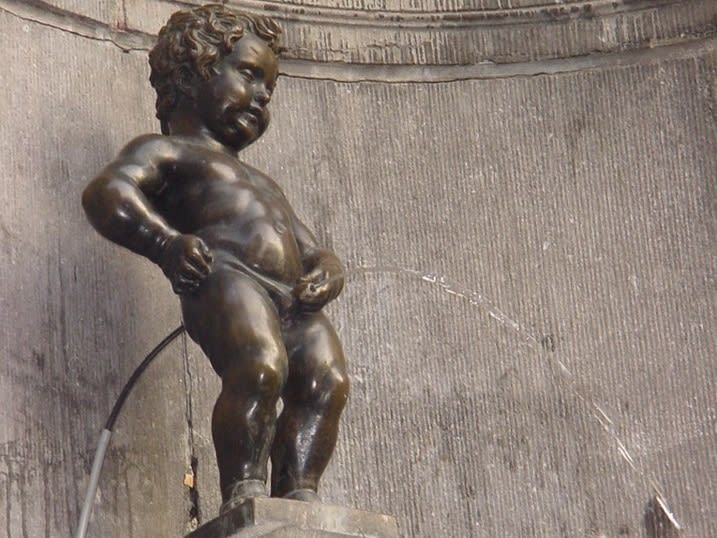
One of the most traditional experiences you can have in Brussels is visiting the Manneken Pis statue. This is one of the city's most iconic and beloved figures, depicting a tiny sculpture of a boy urinating into a fountain. This recreation has captivated the imagination of visitors for centuries and has become an iconic symbol of the Belgian capital.
Located on a picturesque corner near the Grand Place, the statue embodies a playful spirit and sense of humour that reflects the welcoming and somewhat irreverent personality of the city. What's more, the history behind the Manneken Pis statue is enigmatic and full of legends.
Practical information
- How to visit: It is located a few minutes' walk from the Grand Place and is a frequent stop on guided tours of Brussels.
- Price: Free, although tours that include a visit start at RM67
- Tip: If you visit on public holidays or special events, Manneken Pis is dressed in themed costumes, a unique tradition in Brussels.
3. Stroll through the Saint-Hubert galleries

You may be one of those people who think that shopping while travelling is a waste of time, but I can assure you that if you visit the Saint-Hubert Galleries, you will change your mind. These shopping arcades, which stretch for over 200 metres, are one of the city's main attractions.
As well as marvelling at the architecture, you'll find luxury shops, jewellers, famous chocolate shops and terraces where you can enjoy a coffee. Admittedly, most of these establishments are reserved for people with deep pockets, but that's no reason to miss out on the experience of a stroll here.
Practical information
- How to get there: Located in the city centre, a convenient way to get to this and other places in Brussels is by Brussels tourist bus.
- What to see: Luxury shops, chocolate shops and its spectacular glass roof.
- Tip: Buy Belgian chocolate; here are some of the best shops.
4. Visit the Brussels Palace of Justice

If you want to discover one of the most beautiful buildings in Brussels during your trip, which is not usually included in the most popular lists, I recommend visiting the Palace of Justice, an architectural masterpiece that is one of Belgium's best-kept secrets. Located at the top of the Marollen hill, the palace offers panoramic views of the Belgian capital.
The palace's architecture is a mixture of neoclassical and Renaissance styles, and its monumental design reflects the ambition and splendour of the 19th century. The central dome, which rises above the city, is one of the largest in the world and is a recognisable landmark from various points in Brussels. One of the best ways to get to the Palace of Justice while enjoying the surroundings is to take the city's tourist bus.
Interesting details
- Price: Admission is free. If you sign up for the bike tour of Brussels from RM130, you are guaranteed a stop at the Palace of Justice.
- Opening hours: Monday to Friday from 8 a.m. to 5 p.m.
- Location: Pl. Poelaert 1, Brussels.
5. Take in the views of the city from the Atomium

You've probably heard that when the Eiffel Tower was built in Paris, the city's residents were up in arms, even though today it has become the symbol par excellence of the city. The same thing happened with the Atomium in Brussels.
This stainless steel structure, over 100 metres high, was built for the 1958 World's Fair to represent an atom. Today, it is one of the city's symbols. You can buy tickets to the Atomium and go up to enjoy the aerial view of Brussels or eat in the restaurant located in one of its spheres.
Practical information
- How to get there: By metro, tram or bus; it is well connected to the city centre.
- What to see: Exhibition on the 1958 World's Fair and viewpoint with panoramic views.
- Tip: Buy your tickets for the Atomium in advance to avoid queues.
- Price: From RM82
6. Discover the Sablon district

Discovering the Sablon district in Brussels is like stepping into an elegant and sophisticated corner that embodies the cultural and artistic wealth of the city. Located between the Grand Place and the Palace of Justice, this historic neighbourhood is known for its cobbled streets, buildings of varied architectural styles and cosmopolitan atmosphere. Sablon is a melting pot of antique shops, designer boutiques, art galleries and exquisite chocolate shops.
Practical information
- How to get there: It is one of the stops on the guided bike tour of Brussels, an ideal way to explore the city.
- What to see: Antiques market on weekends, art galleries and iconic chocolate shops.
- Tip: Try the handmade chocolate from one of the historic shops in the neighbourhood.
7. Try the exquisite Belgian chocolate

Belgian chocolate surely needs no introduction, at least not among cocoa lovers. I can tell you first-hand that few European cities offer such an exquisite delicacy. You'll have dozens of opportunities to try it as you explore the city, but you can also take one of the chocolate tours of Brussels.
This is a guided tour that first introduces you to chocolate making (you can even taste the raw ingredients during the production process and be amazed at how their flavour changes throughout) and then you can try the different types available.
Practical information
- How to do it: With a chocolate tour or tasting in Brussels that includes tastings and demonstrations.
- What to try: Artisanal chocolate, traditional bonbons and freshly made waffles.
- A tip: Also book the waffle workshop from RM185 for a complete sweet experience. Especially recommended if you are visiting Brussels with children.
8. Visit the Royal Museum of Fine Arts of Belgium

If you want to explore an artistic treasure trove spanning centuries of creation and visual expression, don't miss the Royal Museums of Fine Arts of Belgium. This museum houses a collection of masterpieces of painting, sculpture and decorative arts. Divided into two sections, one dedicated to ancient art and the other to modern art, the exhibition will take you on a journey through time, exploring various artistic trends and cultural movements.
The museum's ancient art section presents a varied collection that includes masterpieces from the Flemish Renaissance and European art up to the 18th century. You can marvel at paintings by Brueghel the Younger, Rubens and Van Dyck, as well as sculptures, decorative objects and applied arts that complement the collection.
The modern art section presents a variety of works ranging from Impressionism to contemporary art. You will find masterpieces by René Magritte and James Ensor, which shape this exhibition in one of the best museums in Brussels.
Details of interest
- Price: Admission costs approximately £13. You can get free admission to the museum with the Brussels Card from RM230
- Opening hours: Tuesday to Sunday from 10:00 to 17:00.
- Location: Rue de la Régence 3, Brussels.
9. and don't miss the Royal Museum of Art and History in Brussels

Continuing with Brussels' museums, the Royal Museum of Art and History is another of the city's must-see attractions. Located in the majestic building of the Parc du Cinquantenaire, this museum is an invaluable treasure trove of artefacts and masterpieces spanning from ancient times to more recent times.
Each museum in this unique complex is dedicated to a specific theme, offering visitors the opportunity to explore diverse artistic expressions and discover the rich cultural heritage of Belgium and the world. You can buy tickets for the Cinquantenaire Museum, as it is also known, and gain access to areas ranging from Egyptian and Roman antiquities to Islamic and Asian art.
In addition, the Musical Instruments Museum, another component of this museum complex, displays a wide range of historical musical instruments that resonate with the evolution of music throughout the ages.
10. Take a break in the Royal Park of Brussels

Walking through Brussels' Royal Park is like stepping into an oasis of tranquillity and beauty in the middle of the bustling city. This park, located in the heart of Brussels, is an iconic green space that offers a peaceful retreat for locals and visitors alike. With its extensive paths, majestic trees and elegant statues, the Royal Park is a testament to the rich history and natural harmony of the Belgian capital.
The park, also known as "Parc de Bruxelles" in French and "Warandepark" in Dutch, is a window into Brussels' aristocratic past. It is flanked by the Royal Palace of Brussels, and the wide open spaces invite you to enjoy a relaxing stroll, a picnic or simply a moment of tranquillity surrounded by nature.
11. Explore the Cathedral of Saint Michael and Saint Gudula

St. Michael and St. Gudula Cathedral, named after two patron saints, stands in the heart of the city, dazzling visitors with its Gothic splendour and rich history. From its façade to its intricate stained-glass windows, the cathedral is a testament to the religious art and cultural influence that has left its mark on Brussels since the 16th century.
The cathedral's architecture reflects the grandeur of the Gothic style. Its tall towers and main nave are a testament to the artistic skill and dedication required to build religious monuments of this magnitude. Inside, you will find stained glass windows, side chapels, ornate altars and sculptures that bring to life the rich tradition of religious iconography.
Details of interest
- Price: Admission is free.
- Opening hours: Every day from 7.30 a.m. to 6 p.m.
- Location: Pl. Sainte-Gudule, Brussels.
12. Follow the comic book route

Why a comic strip route in Brussels? If you read Tintin or Asterix and Obelix comics as a child, you already know the answer: Belgium is a country that has produced some great cartoonists. Today, in addition to visiting the Comic Strip Museum in the capital every day from 10 a.m. to 6 p.m., you can also find various murals in the streets paying tribute to different masters of the comic strip.
Among the most notable murals are The Smurfs, Tintin, Spirou, Lucky Luke, Asterix and Obelix, Titeuf and Marsupilami. You can find information about the official route or let yourself be surprised as you stroll through the city by the different graffiti you find along the way.
13. If you're a fan of Tintin, visit the Hergé Museum

A visit to the Hergé Museum in Brussels will transport you to the exciting world of the creator of one of the most iconic characters in comic book history: Tintin. Located in Louvain-la-Neuve, this museum pays tribute to the talent and creativity of Hergé, the pseudonym of Georges Remi, who brought to life the unforgettable adventures of the intrepid reporter and his friends.
The museum has a diverse collection ranging from original sketches and scripts to Hergé's personal belongings. You can explore the stages of the creative process behind the Tintin stories, from the initial ideas to the final pages of the comics.
The exhibitions are innovatively designed, using multimedia technology to immerse visitors in the worlds of the characters and the settings of the hero's adventures. The Hergé Museum is usually included in Brussels comic book tours.
Details of interest
- Price: Admission costs approximately £15 per person.
- Opening hours: Tuesday to Sunday from 10.30 a.m. to 6 p.m.
- Location: Rue du Labrador 26, Brussels.
14. Visit the European Parliament

The European Parliament is open every day until 6pm, except on special occasions. Inside, you can visit the hemicycle, the plenary chamber and the visitors' centre, which provides detailed information about each country.
It is located in the European quarter, a little way from the centre but easily accessible by metro. If you are visiting the Parliament during your stay in Brussels, don't forget to explore this neighbourhood and some of its main attractions, such as the Belayrmont building, the Council of the European Union, Leopold Park and the Cinquantenaire Palace.
15. Immerse yourself in a miniature world at the Mini-Europe theme park

The Mini-Europe theme park in Brussels offers a miniature world full of charm and wonder. This park provides a unique experience, allowing visitors to explore detailed replicas of iconic monuments and landmarks from across the continent. Mini-Europe captures the essence and diversity of European destinations in one place, offering a visual and educational journey.
The miniatures, which are built to a scale of 1:25, are meticulously crafted and capture the architectural details of the original monuments. From the Eiffel Tower to the Roman Colosseum, the Vienna State Opera House and the Tower Bridge in London, each reproduction is designed to provide an authentic and picturesque view of Europe's cultural and architectural wealth.
Interesting details
- Price: Admission costs approximately £22 per person.
- Opening hours: Tuesday to Sunday from 9.30 am to 6 pm.
- Location: Av. du Football 1, Brussels.
16. Go on a beer tasting tour in Brussels

If chocolate is Brussels' quintessential delicacy, beer is undoubtedly its most famous drink. The Belgian capital is world-renowned for its craft beer, and places like the Delirium Tremens Café boast over 2,000 different brands. You can try them on your own, but if you fancy one of the many beer tours that will take you to the best breweries in Brussels, the experience will be much more complete.
These tours are divided into several parts: the history of beer and its importance in the country, the brewing process and, of course, the tasting. Far from being a boring monologue by the guide, booking a beer tour is more of an opportunity to spend some time relaxing with a local and get to know the city from a less official perspective than when you are sightseeing.
17. Marvel at the Basilica of the Sacred Heart

Located on Koekelberg Hill in Brussels, this imposing church is an architectural testament to devotion and grandeur. Its dome and towers rise majestically above the city, creating a landmark visible from various points in the Belgian capital and providing a place for reflection and contemplation.
The Basilica of the Sacred Heart stands out for its Art Deco and Neo-Byzantine design, which combines classic and modern elements in a unique fusion. The interior of the basilica is equally impressive, with its central nave and high dome creating a sense of spaciousness and solemnity. The stained glass windows and decorations display a rich palette of colours and a level of detail that reflects the attention paid to every aspect of the building.
Details of interest
- Price: Admission is free.
- Opening hours: Every day from 8 a.m. to 6 p.m.
- Location: Basiliekvoorplein 1, Brussels.
18. Tour Brussels from the tourist bus

The city of Brussels is much more than what you can see on a stroll through the centre, but sometimes we don't really know what to see or what to look out for. That's why Brussels' tourist buses have a route designed with audio commentary and panoramic views that takes you all around the city.
Using tourist buses also saves time travelling between the city's different points of interest. It's also a way to avoid the cold Brussels winter and long walks.
How it works
Simply purchase a pass (you can do this online) for one or two days and activate it when you first use it. For 24 or 48 hours, depending on your choice, you will have unlimited access to Brussels' tourist buses, getting on and off as many times as you like and at any stop you choose.
Even if you're using the tourist bus to get between monuments faster than you would on foot or by metro, I recommend taking the full route at least once to listen to the audio commentary about the city and enjoy the views.
19. Walk along Rue des Bouchers and discover its 'bistrots'

Walking along Rue des Bouchers is one of the best ways to discover Brussels' culinary and cultural scene. This picturesque street, located in the historic centre of the city, is famous for its vibrant atmosphere, restaurants and outdoor terraces. Also known as La Rue des Bistrots, this cobbled street is a paradise for foodies.
Rue des Bouchers is dotted with a variety of restaurants offering traditional Belgian dishes and international cuisine. Shop windows filled with culinary delights, from mussels to waffles and sweets, invite passers-by to explore the authentic flavours of the region.
20. Another must-see area in Brussels: the Saint Géry neighbourhood

The Saint Géry neighbourhood in Brussels is one of the city's bohemian and lively corners. In recent years, this district has undergone a revitalisation that combines history and modernity in a very interesting way, with its cobbled streets, historic buildings and an eclectic mix of bars, restaurants and art galleries.
Among the architectural gems of the area, the old Saint Géry church, which gives the neighbourhood its name, has been transformed into a cultural and events space, hosting exhibitions and artistic activities. Place Saint Géry, the epicentre of the neighbourhood, comes alive with its outdoor terraces and festive atmosphere, especially during the markets offering local products and crafts.
21. Discover the romantic city of Bruges

It is very rare for a small city to be more famous than the capital of the country, but in Belgium this is the case with Bruges. The city known as "The Venice of the North" is located an hour from Brussels and is the most visited city in the entire country.
You can visit Bruges on an organised tour or you can get from Brussels to Bruges on your own, but before I give you the details, let me tell you why it is so famous. Bruges is a place criss-crossed by canals and full of medieval buildings and cobbled streets.
The whole city resembles a fairytale landscape, while also being a cultural centre with iconic buildings such as the Basilica of the Holy Blood, the Church of Our Lady, the Town Hall and the Monastery of the Vine.
What are the trips to Bruges like?
Although trips to Bruges are usually day trips, there are other options available. On an organised day trip from Brussels, an expert guide will reveal the city's secrets and show you all its hidden corners. These types of trips also include return transport from the centre of Brussels and, on some occasions, you can book a trip to Bruges that includes Ghent in the itinerary.
The prices of excursions from Brussels to Bruges are quite affordable. For this reason, and because what you will see in Bruges on this type of excursion will give you a very complete idea of the city, I recommend booking an organised excursion. Check whether the tour you choose includes lunch; if not, here are some recommendations for eating in Bruges and some tips if you are taking the trip from Brussels to Bruges with children (whether organised or on your own).
22. Visit other places around Brussels

Bruges isn't the only city near Brussels that you can visit during your trip. Belgium's train network is known for its excellent service and numerous connections. This means that from Brussels you can also reach cities such as Antwerp, Ghent and Liège, either on your own or as part of organised excursions.
If you feel like it, you can also go from Brussels to Amsterdam in a day or visit Luxembourg from Brussels. My advice is to plan your own route with a map and then see which excursions cover the stops you have decided to make, as the price is often well worth it and you will get much more out of your time than if you were travelling on your own.
When to travel to Brussels
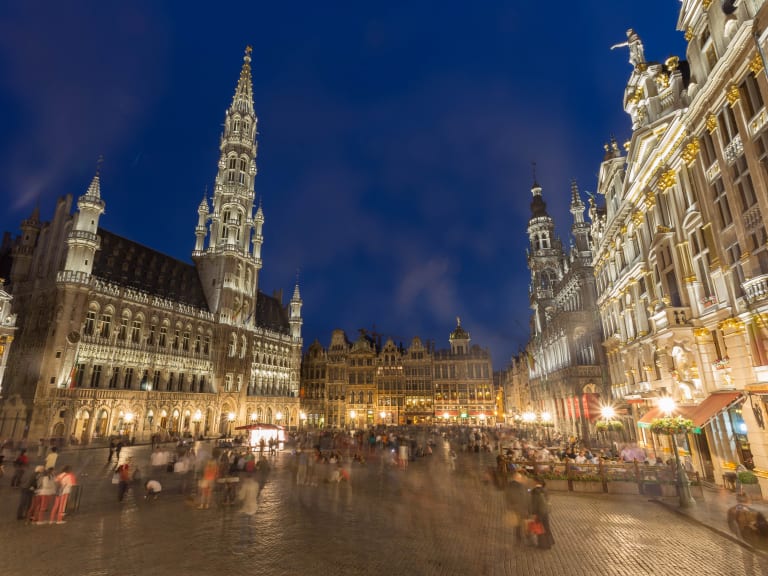
In addition to all the sights in Brussels, the activities you can do if you go to Brussels in summer are very different from those you can do if you visit Brussels at Christmas. Every season has its charm in this city, but since the Belgian capital does not reach extremely high temperatures, August in Brussels is usually among the favourite months for tourists.
If you want to avoid the summer crowds and high prices that can occur in December in Brussels during the Christmas season, I recommend visiting Brussels in March, as the temperatures will not be as cold as in winter and there will not be as many people as in the summer months.
Whenever you go, I recommend getting the Brussels tourist card,the Brussels Card, which will help you get the most out of your trip. You can buy a 24-, 48- or 72-hour pass and customise it with the attractions that interest you most. A great investment!
How many days to see Brussels
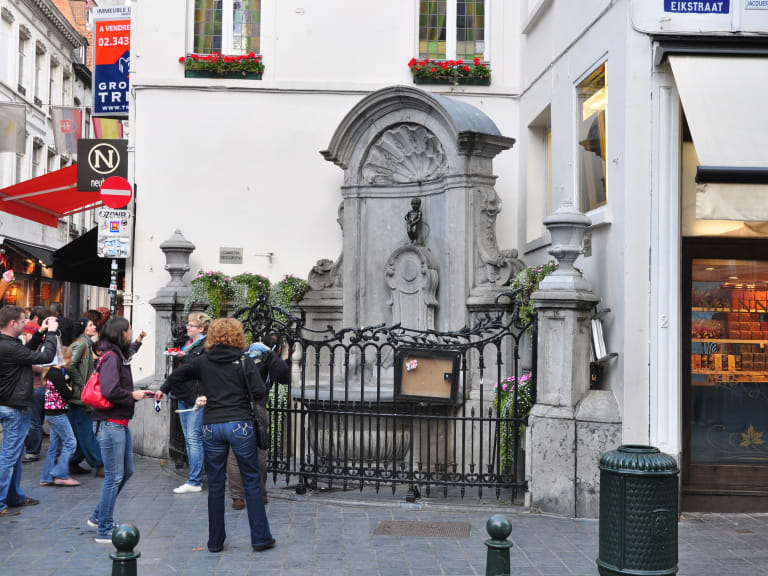
After deciding when to go, you need to decide how long to stay. The city of Brussels can be explored in two days, or you can even see Brussels in one day if you book a transfer from the airport to the city centre and don't waste any time on arrival. However, as it is well connected to nearby cities, you can also spend three days in Brussels or even four days in the Belgian capital and take the opportunity to explore the surrounding area.



